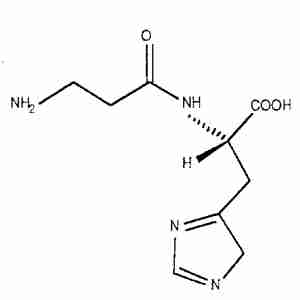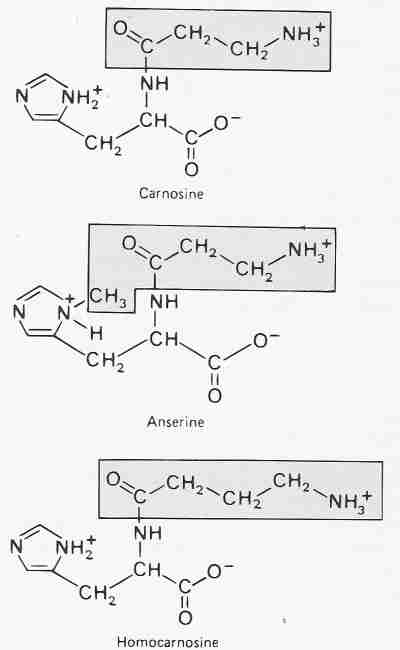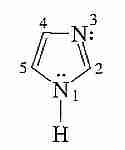
by Ben Best

|
L-Carnosine (ß-alanyl-L-histidine) is a dipeptide composed of the two amino acids ß-alanine and L-histidine. For a small molecule carnosine performs a remarkable variety of functions — most notably anti-oxidation, anti-glycation, pH buffering and chelation of divalent metal cations (particularly copper, Cu2+).
Carnosine is highly concentrated in muscle and brain. Particularly high levels of carnosine have been reported in the muscle of human sprinters and rowers. There is a correlation between species lifespan and tissue carnosine levels. Carnosine concentration is about 3 times higher in rat muscle than in mouse muscle, whereas human muscle has about 10 times the concentration of rat muscle [PROCEEDINGS OF THE NATIONAL ACADEMY OF SCIENCES (USA); Kohen, R; 85(9):3175-3179 (1988)].
Homocarnosine (gamma-aminobutyryl-L-histidine) is a dipeptide composed of the amino acids Gamma-AminoButyric Acid (GABA, the primary inhibitor brain neurotransmitter) and L-histidine. Carnosine and homocarnosine are both produced by the same ATP-driven enzyme, carnosine synthetase, and both molecules exhibit very similar properties. The concentration of homocarnosine in the human brain, however, is about 100 times that of carnosine. It is manufactured by glial cells (oligodendrocytes) except in the olfactory bulb, where it is synthesized by neurons. The highest brain homocarnosine concentrations are found in the substantia nigra, dentate gyrus and olfactory bulb as well as in the cerebrospinal fluid.

|
Anserine (N-methyl carnosine) also has properties similar to carnosine & homocarnosine, but anserine is not found in mammalian muscle or brain. Birds, however, have very high concentrations of anserine in their muscle & brain. It may not be coincidental that anserine has about 5 times the anti-oxidant capability of carnosine and that birds have much longer lifespans than similarly-sized mammals [BIOCHEMISTRY (MOSCOW) 65(7):751-756 (2000)].
The anti-oxidant activity of carnosine is not particulary high compared to Vitamin C & Vitamin E, but the fact that carnosine is water-soluble and can be synthesized as needed (the vitamins must be obtained in the diet) makes it more well-suited for excitable tissues that can vary greatly in metabolic activity. It is the imidazole moiety of histidine and its derivatives that confers anti-oxidant activity. Carnosine and the related molecules are especially effective as hydroxyl radical scavengers, singlet oxygen quenchers and they potently inhibit the conversion of hydrogen peroxide to hypochlorite by myeloperoxidase. Carnosine also is protective against reactive nitrogen species, notably peroxynitrite [NEUROCHEMICAL RESEARCH; Calabrese,V; 30(6/7):797-807 (2005)]. Like deprenyl, carnosine inhibits the generation of free radicals from MonoAmine Oxidase-B (MAO-B) [JOURNAL OF ANTI-AGING MEDICINE; Yuneva,MO; 2(4):337-342 (1999)]. Carnosine is not particularly effective against superoxide, hydrogen peroxide or hypochlorous acid [CELLULAR AND MOLECULAR NEUROBIOLOGY 17(2):259-269 (1997)]. Carnosine seems to act synergistically with Vitamin E, both in increasing tissue concentrations of both nutrients and in reducing oxidative damage to cell membranes [AGE AND AGEING 29:207-210 (2000)].

|
The ability of carnosine (and its homologues) to chelate metal cations — especially copper (Cu2+) — contributes to its anti-oxidant capabilities. Copper concentration is high in skeletal muscle and olfactory bulbs. Both copper and zinc inhibit proteasome function, which suggests that chelation of those metals by carnosine could protect against neurodegeneration [BIOGERONTOLOGY; Hipkiss,AR; 6(2):147-149 (2005)].
The high pH buffering capacity of carnosine is probably valuable in muscle to reduce the acidity of lactic acid produced during times of high physical exertion. These effects also make carnosine a valuable anti-ischemic agent. Additional anti-ischemic effects are protection of Na/K-ATPase from oxygen radicals, prevention of excessive dopamine production [BIOCHEMISTRY (MOSCOW) 65(7):849-855 (2000)], and suppression of sympathetic nerve activity [BIOLOGICAL & PHARMACEUTICAL BULLETIN; Fujii,T; 28(2):361-363 (2005)].
In one series of experiments carnosine increased population doublings (the "Hayflick Limit") by about 10% [EXPERIMENTAL GERONTOLOGY 34(1):35-45 (1999)]. Cellular senescence is usually attributed to telomeres. Human fibroblasts grown with 20 milliMolar carnosine showed slower telomere shortening and a roughly 20% increase in replicative lifespan [BIOCHEMICAL AND BIOPHYSICAL RESEARCH COMMUNICATIONS; Shao,L; 324(2):931-936 (2004)].
Some remarkable effects of the carnosine family of histidine-derivatives, however, are on proteins. Carnosine prevents protein glycation, ie, non-enzymatic cross-linking of proteins induced by sugars. Protein regions containing lysine (especially adjoining proline) are especially vulnerable to glycation, which the structurally similar carnosine may prevent by sacrificial competition. Similarly, carnosine protects proteins from oxidation by sacrificial competition with the easily-oxidized lysine & histidine of proteins. Carnosine prevents aldehyde-induced protein carbonyl groups — protecting cells from acetaldehyde (from alcohol) and MalonDiAldehyde (MDA) damage [ANNALS OF THE NEW YORK ACADEMY OF SCIENCES 854:37-53 (1998)]. In fact, in high concentrations carnosine can reverse protein-aldehyde cross-linking (Advanced Glycation End-products, AGEs) [CURRENT MEDICINAL CHEMISTRY;Guiotto,A; 12(20):2293-2315 (2005)], thereby rejuvenating cultured cells. The anti-glycating effects of carnosine make it protective against diabetic complications like neuropathy [DIABETES;Janssen,B; 54(8):2320-2327 (2005)]
Carnosine may also have a rejuvenating effect by facilitating the degradation of damaged proteins by proteases [ANNALS OF THE NEW YORK ACADEMY OF SCIENCES 959:285-294 (2002)]. The fact that carnosine has rejuvenating and anti-senescent properties not possessed by more powerful anti-oxidants indicates that protein anti-glycation, deamination intervention, carbonyl reaction or inibition of aldehyde-induced cross-linking (or all of these in combination) may be responsible for those properties [same reference]. Carnosine added to the diet of fruit flies increased average lifespan by 20% for males, but had no effect on female lifespan [REJUVENATION RESEARCH; Stvolinsky,S; 13(4):453-457 (2010)].
Carnosine has been shown to block the growth of ß-amyloid peptide aggregates, thereby interfering with a process that is widely believed to be important in the development of Alzheimer's Disease [BIOCHEMICA ET BIOPHYSICA ACTA 1360:17-29 (1997)]. The copper-rich olfactory bulb is typically severely damaged by ß-amyloid plaques and neurofibrillary tangles in Alzheimer's patients. Loss of a sense of smell is an early warning sign of the disease. For this reason carnosine may help prevent Alzheimer's.
Meat is the usual dietary source of carnosine so vegetarians, especially, should consider taking carnosine supplement.